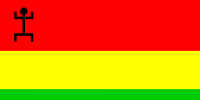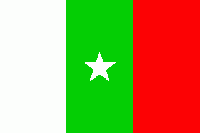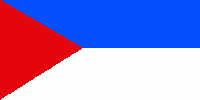Mali
| Conventional short name: | |
| Local: | Mali |
| English: | Mali |

| |
| Languages: | |
| Official: | Dalmatian, Bambara, Maninka, Soninke, Tuareg, Wolof, Dioula |
| Others: | Many |
| Cities: | |
| Capital: | Bamako |
| Largest: | Abixhan |
| Other: | Tomboktu, Dakar |
| President: | Alfa Umar Konare |
| Area: | AREA |
| Population: | POPULATION Malians |
| Independence: | from CSDS |
| Date: | 1958 December 6 |
| Currency: | Malian xenar |
| Organizations: | KSD |
Administration
Government
HOW GOVERNMENT IS ORGANIZED
Administrative Divisions
LIST OF ADMINISTRATIVE DIVISIONS
History
- 1647 First Austro-Dalmatian settlements on the coast
- 1893 Imperial and Royal Crown Colony of Mali established with present borders
- 1945 After Mali is conquered by Ethiopia, a puppet state - Sultanate Mali - was established in the northern part of the area. The southern part became a West Sahara condominum, jointly controlled by Ethiopia and Mali. The Sultanate of Mali invades the Castillian and French colonies in the northwest Africa In conflict with existing QSS - status TBD
- 1948 The Sultanate of Mali was defeated by the allies and the area returned to the Danubian rule In conflict with existing QSS - status TBD
- 1958 Dec Independence, Feliks Hufuet-Buanyi as president
- 1968 Nov 19 Bloodless coup of young officers installs Lt Musa Traore as president
- 1974 New constitution ratified, sealing one-party rule in law
- 1981 Group of 17 officers arrest Traore and call elections; Abdu Xhuf becomes president, serves four terms in which Mali's economy and society strengthens and improves. Close ties with CSDS and subsequently Dalmatia bloom
- 2000 Free and fair elections see Xhuf defeated; Alfa Umar Konare becomes president. Close ties with Dalmatia strengthen even more, economy booming since.
Geography
Borders
North: Maghreb, Libya West: Atlantic Ocean, Gjebaland, Guinea, Pepper Coast South: Atlantic Ocean East: Upper Nigervolta, Gold Coast
Economy
RELEVANT ASPECTS OF THE NATION'S ECONOMICAL SECTOR, EXPORTED PRODUCTS, ETC...
Culture
Languages
Official: Dalmatian, Bambara, Maninka, Soninke, Tuareg, Wolof, Dioula.
Other: Bomu, Tieyaxo Bozo, Toro So Dogon, Maasina, Minyanka, Fula, Mankanya, Pulaar, Baoule, Dan, Anyin, Senufo, others.
Religion
Politics
True to form for Africa, Mali is not without its share of malcontents, mainly in the western coastal region. (Senegal and Gambia *here*) and in the northernmost part. The three largest anti-government movements are the ULS, the MSDK and the AZAWAD.
ULS: Usztra da Liaraciun da Senegal. (In Wolof: Hâré Musalkat fă Dekă u Ndar) Primarily composed of Wolof people unhappy with being dominated by Maninka from Bamako.
MSDK: Mobiamenta da Silele Demokratiske da Kasmanse. South of the Gambia river, the Kasmanse are another group unhappy with the Bamako government, but the MSDK is considerably smaller than the ULS. Further, they not only fight against the Malian government but against the ethnically Wolof ULS.
AZAWAD: aka Tuareg Liberation Front. Centered on Tomboktu, the AZAWAD wants to secede from Mali to form a Tuareg state. AZAWAD also operates in Maghreb, and have close ties to the ALO in Libya.
Mali has been reasonably quiet lately. The Tuareg Liberation Front (AZAWAD) was hit hard about a year ago by Malian Army, and they seem not yet to have recovered. In the west of Mali (Senegal *here*), the MSDK (Mobiamenta da Silele Demokrateske da Kasmanse, Movement of Kasmanse Democratic Forces) were nearly wiped out by their rivals, the ethnically Wolof ULS (Usztra da Liaracun da Senegal, Senegal Liberation Army). After that transpired the Malian government quickly rounded up the remaining known MSDK members and sympathisers and did whatever with them, but the ULS have remained largely quiet since then, content with semi-regularly robbing trains on the Dakar-Bamako railway.
In exchange for the use of the Luderitz naval base following its transfer to the Dominion of Southwest Africa, Dalmatia gave the Royal Air Force of the Federated Kingdoms year-round use of the DAF's Abuja Airbase in eastern Gold Coast. The RAF is permitted to do with the base as they see fit, including the building hangars and other facilities there as it sees fit, and may make use of the training range in eastern Gold Coast as well, several times a year. Further, there is a standing invitation to the RAF to send a squadron to the DAF's annual two-week combat exercises in Mali at the base of the 1523 Sqn. Different years see different arrangements: one year, maybe the RAF squadron flies against a combined Dalmatian/Malian side; another year, the Dalmatians against a combined RAF/Malian side. In every case though, it makes for good practice for the pilots and ground crews of all parties involved.
| |||
|---|---|---|---|
| Full Members | |||
| Dalmatia | Kongo | Gold Coast | Mali | Togo | Upper Nigervolta | |||
| Associate Members | |||
| New Dalmatia | |||
| Observers | |||
| Louisianne |




